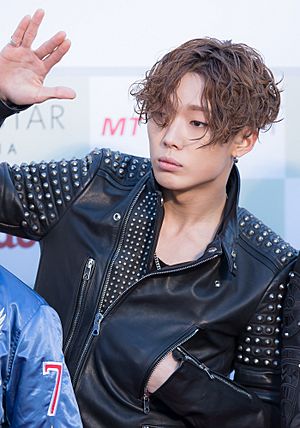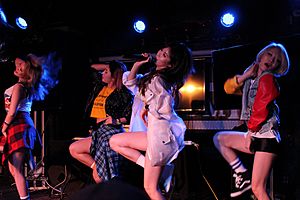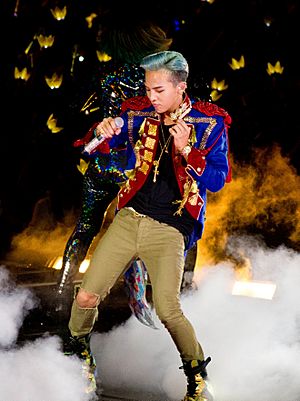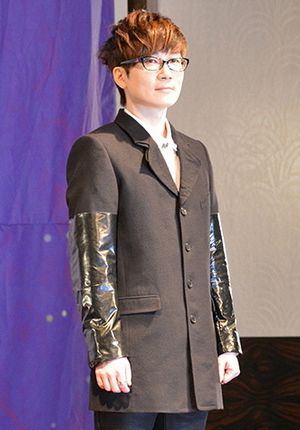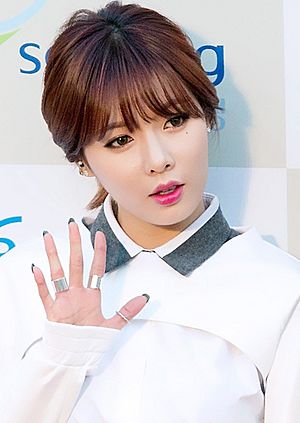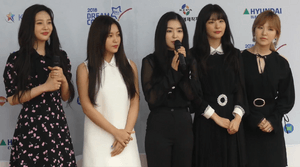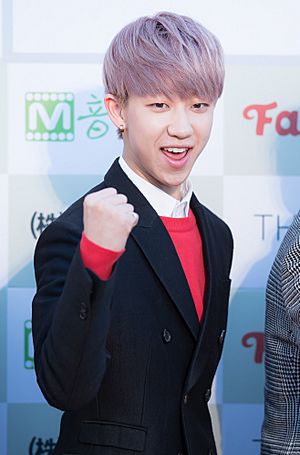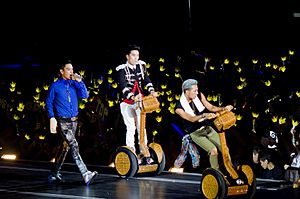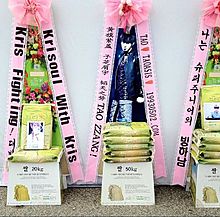K-pop facts for kids
Quick facts for kids |
|
|---|---|
| Stylistic origins | Electronic • Hip hop • Pop • Rock • R&B • Dance • Bubblegum pop |
| Cultural origins | Mid to late 1990s, South Korea |
| Typical instruments | Vocals • Drum pad • Drums • Electric bass • Keyboards • Piano • Sampler • Sequencer • Synthesizer • Occasional use of various other instruments |
K-pop (abbreviation of Korean pop) is characterized by a wide variety of audiovisual elements. While the modern form of K-pop can be traced back as early as to early 90s, the term has been popularized since 2000s and replaced the term Gayo which also refers to domestic pop music in South Korea.
Although it generally classifies "popular music" within South Korea, the term is often used in a narrower sense to describe a modern form of South Korean pop that is influenced by styles and genres from around the world, such as experimental, jazz, gospel, hip hop, R&B, reggae, electronic dance, folk, country, and classical on top of its uniquely traditional Korean music roots.
The more modern form of the genre emerged with one of the earliest K-pop groups, Seo Taiji and Boys, forming in 1992. Their experimentation with different styles and genres of music and integration of foreign musical elements helped reshape and modernize South Korea's contemporary music scene.
Modern K-pop "idol" culture began with the boy band H.O.T. in 1996, as K-pop grew into a subculture that amassed enormous fandoms of teenagers and young adults. After a slump in early K-pop, from 2003 TVXQ and BoA started a new generation of K-pop idols that broke the music genre into the neighboring Japanese market and continue to popularize K-pop internationally today.
With the online social networking services and Korean TV shows, the current global spread of K-pop and Korean entertainment, known as the Korean Wave, is seen not only in East and Southeast Asia but also Latin America, India, North Africa, the Middle East and the Western world, gaining a widespread global audience.
Contents
Training of artists
Management agencies in South Korea offer binding contracts to potential artists, sometimes at a young age. Trainees live together in a regulated environment and spend many hours a day learning music, dance, foreign languages and other skills in preparation for their debut. This "robotic" system of training is often criticized by Western media outlets. In 2012, The Wall Street Journal reported that the cost of training one Korean idol under S.M. Entertainment averaged US$3 million.
K-pop is a cultural product that features “values, identity and meanings that go beyond their strictly commercial value.” It is characterized by a mixture of Western sounds with an Asian aspect of performance. For some, the transnational values of K-pop are responsible for its success. Some examples of the transnational values inherent in K-pop that may appeal to those from different ethnic, national, and religious backgrounds include a dedication to high-quality output and presentation of idols, as well as their work ethic and polite social demeanour, made possible by the training period.
Marketing
Many agencies have presented new idol groups to an audience through a "debut showcase", which consists of online marketing and television broadcast promotions as opposed to radio. Groups are given a name and a "concept", along with a marketing hook. These concepts are the type of visual and musical theme that idol groups utilize during their debut or comeback. Concepts can change between debuts and fans often distinguish between boy group concepts and girl group concepts.
Concepts can also be divided between general concepts and theme concepts, such as cute or fantasy. New idol groups will often debut with a concept well known to the market to secure a successful first debut. Sometimes sub-units or sub-groups are formed among existing members. An example subgroup is Super Junior-K.R.Y. which consists of members Kyuhyun, Ryeowook, and Yesung, and Super Junior-M, which became one of the best-selling K-pop subgroups in China.
Online marketing includes music videos posted to YouTube in order to reach a worldwide audience.
Choreography
Dance is an integral part of K-pop. When combining multiple singers, the singers often switch their positions while singing and dancing by making prompt movements in synchronous, a strategy called "formation changing". The K-pop choreography often includes the so-called "point dance", referring to a dance made up of hooking and repetitive movements within the choreography that matches the characteristics of the lyrics of the song.
Super Junior's "Sorry Sorry" and Brown Eyed Girls' "Abracadabra" are examples of songs with notable "point" choreography. To choreograph a dance for a song requires the writers to take the tempo into account. According to Ellen Kim, a Los Angeles dancer and choreographer, a fan's ability to do the same steps must also be considered: Consequently, K-pop choreographers have to simplify movements.
The training and preparation necessary for Kpop idols to succeed in the industry and dance successfully is intense. Training centers like Seoul's Def Dance Skool develop the dance skills of youth in order to give them a shot at becoming an idol . Physical training is one of the largest focuses at the school, as much of a student's schedule is based around dance and exercise . The entertainment labels are highly selective, so few make it to fame. Students at the school must dedicate their lives to the mastery of dance in order to prepare for the vigorous routines performed by Kpop groups. This of course means that the training must continue if they are signed. Companies house much larger training centers for those who are chosen.
Fashion
K-pop has a significant influence on fashion in Asia, where trends started by idols are followed by young audiences. Some idols have established status as fashion icons, such as G-Dragon and CL, who has repeatedly worked with fashion designer Jeremy Scott, being labeled his "muse."
There is some concern over trends such as skin whitening being popularised by the industry, which has been criticised for its narrow beauty standards.
The emergence of Seo Taiji & Boys in 1992 paved the way for the development of contemporary K-pop groups that fans interact with today. Seo Taiji & Boys revolutionized the Korean music scene by incorporating rap and American hip-hop conventions into their music. This adoption of Western style spread into the fashions worn by the boy band, and the boys adopted the hip-hop aesthetic.
As K-pop "was born of post-Seo trends," many acts that followed Seo Taiji & Boys adopted the same fashion style. Deux and DJ DOC can also be seen wearing on-trend hip-hop fashions such as sagging baggy pants, sportswear, and bandanas in their performances. With Korean popular music transforming into youth-dominated media, manufactured teenage idol groups began debuting in the mid and late '90s, wearing coordinated costumes that reflected the popular fashion trends among youth at the time.
Hip-hop fashion, considered the most popular style in the late '90s, remained, with idol groups H.O.T. and Sechs Kies wearing the style for their debut songs. The use of accessories elevated the idol's style from everyday fashion to performance costume, as ski goggles (worn either around the head or neck), headphones worn around the neck, and oversized gloves worn to accentuate choreography moves were widely used.
H.O.T.'s 1996 hit "Candy" exemplifies the level of coordination taken into account for idol's costumes, as each member wore a designated color and accessorized with face paint, fuzzy oversized mittens, visors, bucket hats, and earmuffs, and used stuffed animals, backpacks, and messenger bags as props. While male idol groups' costumes were constructed with similar color schemes, fabrics, and styles, the outfits worn by each member still maintained individuality. On the other hand, female idol groups of the '90s wore homogeneous costumes, often styled identically. The costumes for female idols during their early promotions often focused on portraying an innocent, youthful image.
K-pop showed significant trends over the past few decades. The rise of ulzzang style parallels the K-pop phenomenon, hence many K-pop idols adopted the look, which is described as “huge, delicate bambi-like eyes with double lids and a tiny, delicate nose with a high bridge are a prerequisite. Smooth, pale snow-white skin, and rosebud lips are also desirable. So is a small and sharp chin to achieve the perfect “V-line” face, which should ideally be no bigger than the size of your palm".
This look was nearly impossible to gain naturally, giving rise to the popularity of circle contact lenses, plastic surgeries, and skin-whitening products. As K-pop became a modern hybrid of Western and Asian cultures starting from the late 2000s, fashion trends within K-pop reflects diversity and distinction as well. Fashion trends from the late 2000s to early 2010s can largely be categorized under the following:
- Street: focuses on individuality, bright colors, mix-and-match styling, graphic prints, sports brands such as Adidas and Reebok (e.g. 2NE1-Fire, SHINee-Ring Ding Dong, etc.)
- Retro: aims to bring back "nostalgia" from the 1960s to 1980s, dot prints, detailed patterns, common clothing items include denim jackets, boot-cut pants, wide pants, hair bands, scarves, and sunglasses (e.g. Wonder Girls-Nobody, Tiara-Roly Poly, etc.)
- Cute: highlights femininity and masculinity, outfits made of satin, lace, fur, and leather, common clothing items include mini skirts, corsets, net stockings, high heels, sleeveless vests, see-through shirts (e.g. Girls' Generation-The Boys, After School, TVXQ-Mirotic, etc.)
- Black & White: emphasizes modern & chic, symbolizes elegance & charisma, mostly applied to formal wear (e.g. Girls' Generation-Genie, Super Junior-Sorry Sorry, Beast-Fiction, etc.)
- Futurism: commonly wore with electronic and hip-hop genres, popping color items, metallic details and prints, aims to have a futuristic outlook (e.g. 2NE1-I am the Best, Wonder Girls-Like Money, NCT U-Seventh Sense, etc.)
Government support
The South Korean government has acknowledged benefits to the country's export sector as a result of the Korean Wave. Government initiatives to expand the popularity of K-pop are mostly undertaken by the Ministry of Culture, Sports and Tourism, which is responsible for the worldwide establishment of Korean Cultural Centers. South Korean embassies and consulates have also organized K-pop concerts outside the country, and the Ministry of Foreign Affairs regularly invites overseas K-pop fans to attend the annual K-Pop World Festival in South Korea.
In addition to the use of the popularity of K-pop for benefits to the country’s export sector in economic perspective, the South Korean government has been taking advantage of the influence of K-pop in diplomacy. A representative example of the South Korean government effort in diplomacy exploiting K-pop as a tool can be Mnet Asian Music Awards (MAMA). MAMA, started with the opening statement of Park Geun-hye (the Korean president at the time), was K-pop music awards hosted by Mnet in Hong Kong in 2014. This event is considered to have power for South Korea to strengthen nation’s reputation and political influence towards the world.
Another relatively recent instance can be K-pop singers’ performances in North Korea. There were a few precedents, terminated in 2005, that Korean pop singers visited North Korea to perform before North Korean audiences. After about a decade, approximately 190 of South Korean performers including well-known South Korean musicians, Red Velvet (band), Lee Sun-hee (singer), Cho Yong-pil, and Yoon Do-hyun, were sent to Pyongyang in North Korea for performance on March 31st and April 3rd in 2018. Kim Jung-un also attended as an audience.
21st century: Rise of Hallyu
K-pop's increasing popularity forms part of Hallyu, or the Korean Wave, which refers to the popularity of South Korean culture in other countries. K-pop is increasingly making appearances on Western charts such as Billboard. The development of online social media has been a vital tool for the Korean music industry in reaching a wider audience. As part of the Korean Wave, K-pop has been embraced by the South Korean government as a tool for projecting South Korea's soft power abroad, particularly towards overseas youth. In August 2014, the prominent British news magazine The Economist dubbed Korean pop culture "Asia’s foremost trendsetter".
K-pop has began an entire industry encompassing music production houses, event management companies, music distributors, and other merchandise and service providers. The three biggest companies in terms of sales and revenue are S.M. Entertainment, YG Entertainment and JYP Entertainment, often referred to as the 'Big Three'. These record labels also function as representative agencies for their artists. They are responsible for recruiting, financing, training, and marketing new artists as well as managing their musical activities and public relations. Currently, the agency with the greatest market share is S.M. Entertainment. In 2011, together with Star J Entertainment, AM Entertainment, and Key East, the Big Three companies founded the joint management company United Asia Management.
Record charts
Korean record charts include the Gaon Digital Chart and the Billboard K-pop Hot 100. Some K-pop records have appeared on the Oricon Albums Chart of Japan and the Billboard Hot 100 of the United States.
In 2009, singer Hwangbo entered the European music industry for a short period when she released the single R2song, reaching # 1 on the world's largest dance music site JunoDowload, being successful in the United Kingdom, Europe, as well as Korea; becoming the first Asian artist to achieve it.
In May 2014, Exo became the third K-pop act to enter the Billboard 200 that year after 2NE1, Girls' Generation and Wonder Girls were the first K-Pop act to chart on Billboard 200.
In October 2016, BTS's album Wings becomes the first Korean album to chart in the UK Album Charts, reaching #62, and the highest-charting and best selling K-pop album in the Billboard 200. In February 2017, BTS landed their fourth album You Never Walk Alone at #61 on the Billboard 200. In September 2017, BTS landed at #14 on the UK Album Charts with their new album, Love Yourself: Her. Love Yourself: Tear debuted at number one on the US Billboard 200 with 135,000 album-equivalent units (including 100,000 pure album sales), becoming BTS' highest-charting and first number one album in the US, the first K-pop album to top the US albums chart, and the highest-charting album by an Asian act. "Fake Love" peaked at number ten on the Billboard Hot 100 that same week, becoming the band's highest reaching song on the chart as well as their first in the top ten. Overall, only twenty non-English songs have reached the top ten, with "Fake Love" being the first for a K-Pop group. The single also debuted at number seven on Billboard's Streaming Songs chart with 27.4 million streams earned in the week ending May 24, giving BTS its first top ten on the chart and making "Fake Love" to land on top ten. In August 2020, their song "Dynamite" topped the Billboard Hot 100 in its opening week, becoming the group's first number-one single in the US and their fourth top-10 entry. BTS became the first K-pop act in Hot 100 history to debut at number one.
In June 2018, YG Entertainment's girl group Blackpink became the first K-pop girl group to hit within the top 50 of Billboard 200 album chart; their first mini-album SQUARE UP debuted at No. 40. Their title song "Ddu Du Ddu Du" charted at No. 55 on the Billboard Hot 100 chart, making it the highest-charting song and the first full Korean-language song by a K-pop girl group. Since then, they have beaten their own record with Ice Cream peaking at #13 on the Billboard Hot 100.
Culture
K-pop artists are frequently referred to as idols or idol groups. Groups usually have a leader, who is often the eldest or most experienced member and speaks for the group. The youngest group member is called the maknae (Hangul: 막내; RR: mangnae). The popular use of this term in Japan was influenced by boy group SS501 when they expanded their activities in the country in 2007. Its Japanese translation man'ne (マンネ) was often used to name the group's youngest member Kim Hyung-jun in order to differentiate him from their leader with a similar name and spelling, Kim Hyun-joong.
Appeal and fan base
Many fans travel overseas to see their idols on tour, and tourists commonly visit Korea from Japan and China to see K-pop concerts. A K-pop tour group from Japan had more than 7,000 fans fly to Seoul to meet boy band JYJ in 2012, and during JYJ's concert in Barcelona in 2011, fans from many parts of the world camped overnight to gain entrance. A 2011 survey conducted by the Korean Culture and Information Service reported that there were over 3 million active members of Hallyu fan clubs.
Bang Si-hyuk, the music industry executive behind BTS, expressed that K-pop idol fans view their idol differently from how music fans view a typical singer. Idol fans want to feel close to and be a part of their idol's lifestyle, even outside of live performances.
An article by The Wall Street Journal indicated that K-pop's future staying power will be shaped by fans, whose online activities have evolved into "micro-businesses." K-pop groups commonly have dedicated fan clubs with a collective name and sometimes an assigned colour, to which they will release merchandise. For example, TVXQ fans are known as 'Cassiopeia,' and their official colour is 'pearl red.' Some of the more popular groups have personalized light sticks for use at concerts; for example, Big Bang fans hold yellow crown-shaped light sticks.
Fan clubs sometimes participate in charity events to support their idols, purchasing bags of 'fan rice' in order to show support. The rice bags are donated to those in need. According to Time, for one of BigBang's shows, 12.7 tons of rice were donated from 50 fan clubs around the world. There are businesses in Korea dedicated to shipping rice from farmers to the venues. Another way that fan clubs show their devotion is by sending lunch to idols during their schedules, and there are catering companies in South Korea specifically for this purpose. Increasingly, fans participate in activism that extends outside of the K-pop community.
A unique feature of K-pop fandom is the "fan chant". When an idol group releases a new song, chants, usually consisting of group members' names, are performed by live concert audiences during non-singing parts of songs.
Images for kids
-
Marilyn Monroe entertaining American soldiers in Korea in 1954
-
Girls' Generation at SM Town Live NY in 2011
-
2NE1 at a press conference in Manila
-
Donika Sterling, an American K-Pop fan diagnosed with Charcot–Marie–Tooth disease, was sponsored to meet her favourite idols in South Korea.
-
Rain at the 2011 Time 100 gala at Lincoln Center in New York City
See also
 In Spanish: K-pop para niños
In Spanish: K-pop para niños




